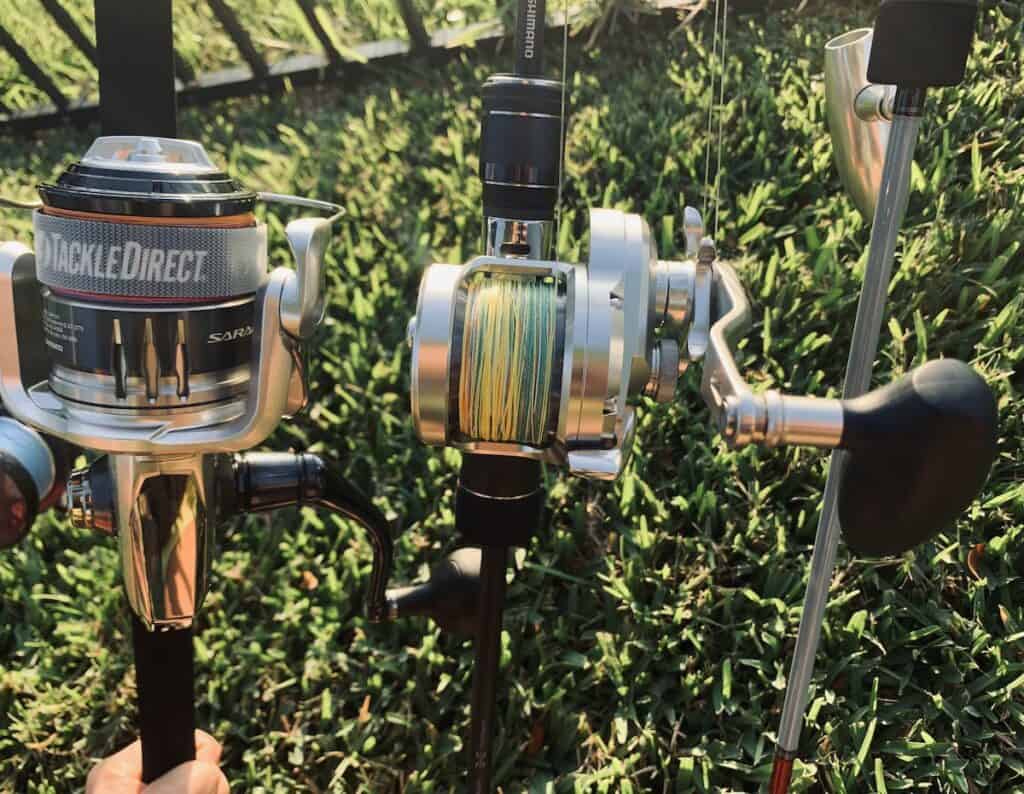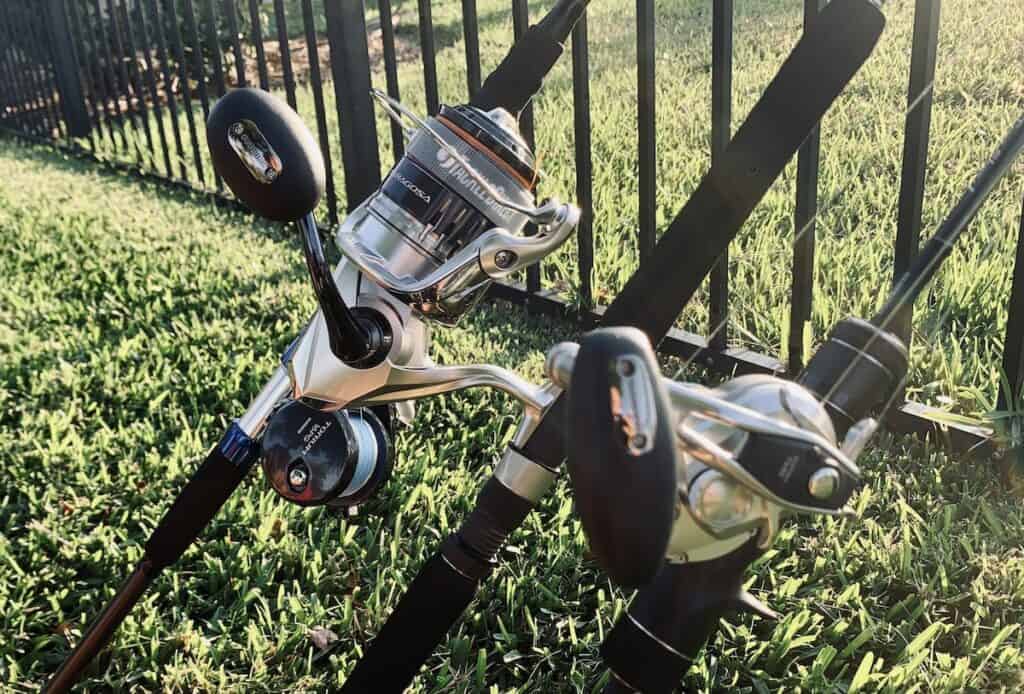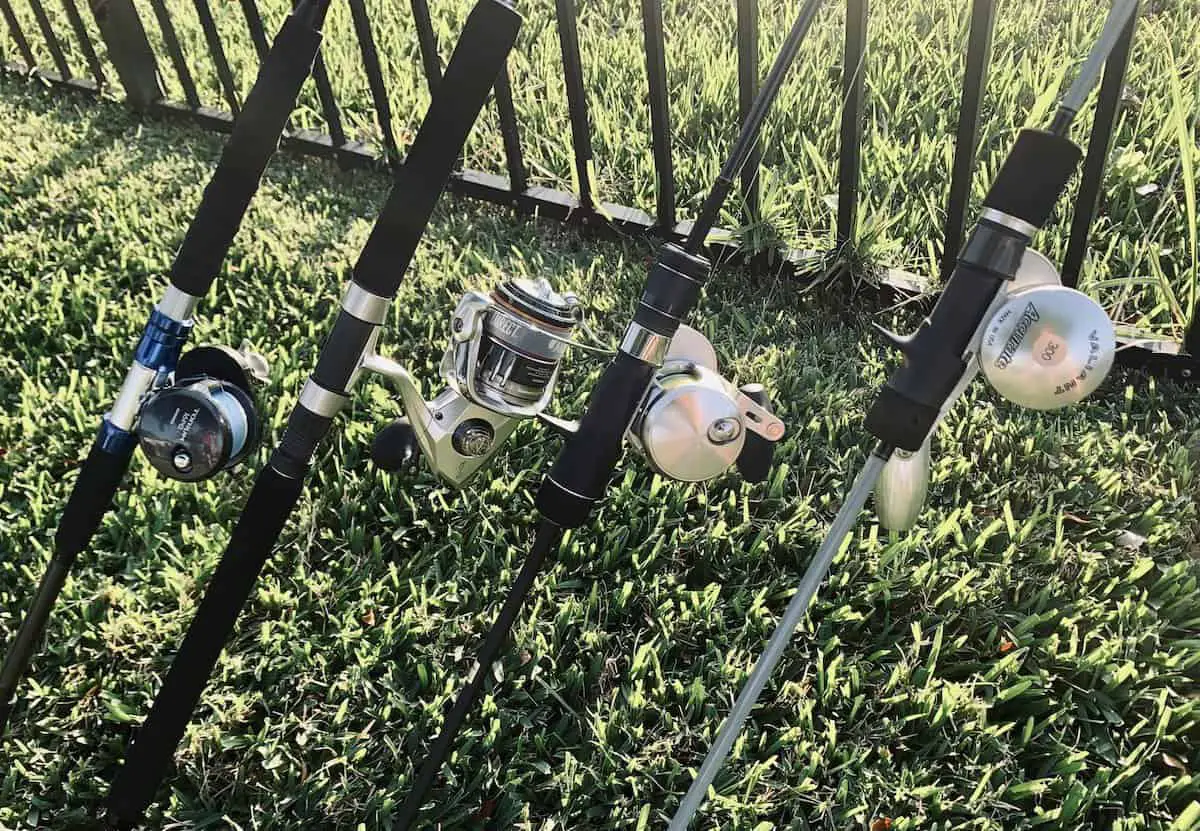Jigging is one of the best fishing techniques. It can be done in a variety of environments, including offshore, inshore, and even ice fishing. High speed vertical jigging and slow pitch jigging are two of the most common types of jigging and require different reels.
Most likely the first decision to make when looking at a reel is whether you need a conventional or a spinning reel. A conventional reel has the spool axis perpendicular to the rod. A spinning reel has the spool axis parallel to the rod. Both styles will work, so how do you know which kind to buy?
Spinning or Conventional?
For slow pitch jigging, a technique in which the angler lets the jig fall slowly to the ocean floor, then jigs it up and then lets it fall again is most easily done with a conventional reel. The angler is typically palming the reel and controlling the rate of freespool using his or her thumb to apply pressure to the spool. A narrow conventional reel effectively levelwinds itself, so there is no need to worry about this complicating the technique. In slow pitch jigging, a slack line is key for the jig to show its action.

In high speed vertical jigging, the angler is again holding the rod and reel and retrieving as fast as he or she can. The jig is worked on a taut line, and the angler must be able to rapidly retrieve it while doing a twitch and pause pattern. For this reason, the best reel style is one that the angler can effectively work. A conventional reel and a spinning reel will both work well for high speed vertical jigging. Conventional reels have the edge over spinning reels when it comes to big fish in deep water because the reel body is often made with extremely strong materials.
My article Speed Jigging and Slow Pitch Jigging: Is Speed the Only Difference? discusses the differences in the two types of jigging.
Line Capacity/Reel Size
Whether you’re doing slow pitch jigging or high speed vertical jigging, you’ll most likely begin by getting the jig down to the ocean floor. Depending on the water depth, this requires a lot of line. When choosing your reel size, it’s imperative that you estimate the water depth you’ll most often be jigging in.
As a rough estimate, I turn to a TopSpot map for my local area. Looking at the offshore areas I’ll typically target, I can get a feel for my usual water depth. I know I’ll most often jig in waters about 250 feet or less, so I’ll lean towards the lower line capacity reels.
Knowing your water depth isn’t quite enough to determine your reel size. Since line capacity also depends on the diameter of the line, and therefore depends on the type of line and strength of the line, you’ll need to also know the line you’ll use. For jigging, my article Braid vs Mono for Jigging talks in great detail about why braid is best for the main line in both high speed vertical jigging and slow pitch jigging.
The two types of jigging require different line strengths. In slow pitch jigging, very light line is used to help the line cut through the deep water better. Most likely, you’ll spool your slow pitch reel with 30 lb test braid. For high speed vertical jigging, heavier line is needed because of the rougher method of fishing and the harder strikes you’ll get. Generally, most people go between 40 lb test and 65 lb test braid.
The weight of a jigging reel is also important to consider, especially for slow pitch jigging. In slow pitch jigging, the angler is holding the setup for long periods of time and every ounce matters. This is especially true if the angler is prone to fatigue, such as a kid or a senior. It’s less important in a speed jigging reel because the duration is much shorter.
The table below shows the line capacity and weight of some common jigging reels. Although it pains me to say it, keep in mind that the advertised braid capacity specs often seem unreachable. Everytime I get a reel spooled, they don’t hit these numbers. It’s likely for a variety of reasons including leaving room for a leader, and less than perfect tension during spooling. I say this to make sure you know that it’s unlikely you’ll be able to hit these yardages.
| Speed/Slow | Spin/Conv | Model | Braid Capacity | Weight | Price | |
| Shimano Ocea Jigger | Slow | Conv | OCEAJG1500HG | 40/300 | 14.3oz | $520 |
| Accurate Boss Valiant | Slow | Conv | BV-300-SPJ | 30/325 | 9.9oz | $480 |
| Shimano Saragosa SW | Speed | Spin | SRG8000SWAHG | 40/340 | 23.8oz | $280 |
| Daiwa Saltiga | Speed | Spin | SALTIGA8000H | 40/330 | 23.1oz | $1,000 |
| Avet JX 6/3 MC 2 Speed | Speed | Conv | JX 6/3 MC Blue | 40/1130 | 23 oz | $330 |
Drag
When opting for a conventional reel, you’ll see reels with star drag or lever drag. Both of these drag types will work, they’re simply different styles. Star drags work by applying pressure to a stack of drag washers against the drive gear. The drive gear becomes harder to turn, making it more difficult to turn the spool that’s connected to it via the pinion gear.
Lever drags work by applying pressure to a drag washer that is directly in contact with the spool. As the pressure increases, it becomes harder for the spool to turn when line is pulled off. Both lever drag and star drag are capable of providing enough drag to stop strong and fast fish, although lever drag tends to have slightly higher max drag.
The drag on spinning reel works by adjusting the knob at the top of the reel to increase or decrease. When the knob is turned, the washer stack at the bottom of the reel is squeezed tighter against the spool or let loose. Similar to a lever drag system, this pressure is against the side of the spool and makes it more or less difficult for line to come off.
The table below shows common jigging reels, their drag type and their max drag. Your drag setting should always be between 25-30% of the breaking strength of the line. So for example, when slow jigging with 30 lb test line, your drag would be set at about 10 lbs. All of these reels can adequately provide that much drag.
| Speed/Slow | Spin/Conv | Model | Max Drag | Spin/Star/Lever | |
| Shimano Ocea Jigger | Slow | Conv | OCEAJG1500HG | 15lb | Star |
| Accurate Boss Valiant | Slow | Conv | BV-300-SPJ | 23lb | Lever |
| Shimano Saragosa SW | Speed | Spin | SRG8000SWAHG | 35lb | Spin |
| Daiwa Saltiga | Speed | Spin | SALTIGA8000H | 55lb | Spin |
| Avet JX 6/3 MC 2 Speed | Speed | Conv | JX 6/3 MC Blue | Strike 15, Full 20 | Lever |
Handle
In slow pitch jigging, the angler is holding the setup and working the jig for long periods of time. And by “long periods of time”, I mean anywhere from 30 minutes to a couple hours straight. Designers of slow pitch jigging reels have thought about this and designed a “banana handle” that’s shaped similarly to a banana or a long football to help fight grip fatigue.

The handle arms have also been lengthened on slow pitch jigging reels. This helps give the angler more torque when hoisting up big bottom feeders.
High speed vertical jigging is tiresome and therefore isn’t performed for nearly as long durations. The reel handle is not considered a source of fatigue.
Gear Ratio/Retrieve Rate
Gear ratio can be one of the most difficult specs for anglers to choose. There’s often conflicting information about it, which leaves the angler wondering which gear ratio is best for jigging? For slow pitch jigging, a high gear ratio is best. I recommend looking for about 5:1 or 6:1 ratio. This will give you a faster retrieve rate, which helps you pull in jigs and fish many yards quickly.
Some slow pitch jigging reels, such as the Accurate Boss Valiant SPJ, also come in a two speed option. This allows you to use a low and powerful gear ratio to winch a grouper out of the reef, and also let’s you switch to high gear ratio and faster retrieve rate for the long pull up.
| Speed/Slow | Spin/Conv | Model | Gear Ratio | Retrieve Rate | |
| Shimano Ocea Jigger | Slow | Conv | OCEAJG1500HG | 6.4:1 | 39IPT |
| Accurate Boss Valiant | Slow | Conv | BV-300-SPJ | 6:1 | 38IPT |
| Shimano Saragosa SW | Speed | Spin | SRG8000SWAHG | 5.6:1 | 42IPT |
| Daiwa Saltiga | Speed | Spin | SALTIGA8000H | 5.8:1 | 43.7IPT |
| Avet JX 6/3 MC 2 Speed | Speed | Conv | JX 6/3 MC Blue | 6:1/3.8:1 | 46/22IPT |
High speed jigging can be done with either a high or low gear ratio. You may want a higher gear ratio, and thereby a faster retrieve rate, when dealing with very deep waters. It can be a test to your physical fitness to speed jig all the way up the water column. However, in shallower depths or when you need to hoist fish up and out of structure, the power of a low gear ratio will help.
It’s important for you to understand that you can succeed with any gear ratio. To ultimately choose which ratio is best for you, consider whether you will need the power to bring in grouper more often, or the fast retrieve rate up the water column more often. And don’t forget about the 2 speed reels that offer the best of both worlds.
Materials and Construction
When jigging in saltwater, whether it’s slow pitch or high speed, you should make sure your reel is protected against the harsh saltwater environment. Typically an anodized aluminum is used and provides great protection.
Some anglers will see the bearing count spec and automatically assume that more bearings is better. More bearings is not always necessary. Manufacturers can get bearing counts high, around 9 or so bearings, by using bearings in locations where a bushing would work just fine. The more important aspect of bearings is their protection against the elements. Shimano offers Anti-Rust Bearings (ARB) which are good, but the next level up is a Shielded Anti-Rust Bearing (S-ARB). If you want you reel to last as long as possible and will frequently use it in saltwater, I urge you to consider the quality of the ball bearings over the quantity.
I hope this article has helped you understand some of the specs behind jigging reels. I wrote another article specifically on slow pitch jigging reels that you can read here.

